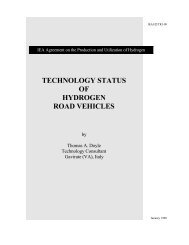Edited by Mary Rose de Valladares M.R.S. Enterprises, LLC ...
Edited by Mary Rose de Valladares M.R.S. Enterprises, LLC ...
Edited by Mary Rose de Valladares M.R.S. Enterprises, LLC ...
Create successful ePaper yourself
Turn your PDF publications into a flip-book with our unique Google optimized e-Paper software.
Figure2: SEM image of ZnO nanorod<br />
array (a) uncoated and (b) coated with<br />
Fe 2 O 3 (CSIRO).<br />
Figure3: Mo<strong>de</strong>l for carbon incor<br />
poration at a Ti vacancy site in rutile<br />
(CSIRO).<br />
At the Centre for Materials Research<br />
in Energy Conversion of the University<br />
of New South Wales (UNSW), the for<br />
mation of titanium vacancies in gassolid<br />
TiO 2 interface and the <strong>de</strong>termination of<br />
the rate of their propagation in the TiO 2<br />
bulk lattice has been discovered. This<br />
led to the successful <strong>de</strong>velopment of<br />
ptype TiO 2 at elevated temperatures of<br />
up to 1050°C. This allows the prepa<br />
ration of ptype TiO 2 without the need<br />
to incorporate foreign ions into the<br />
TiO 2 lattice. They were found to form<br />
a segregationinduced potential bar<br />
rier that retards charge transfer. TiO 2<br />
quasimetallic properties, which should<br />
allow the construction of PEC cells with<br />
enhanced charge transport. In addition,<br />
surface sites have been<br />
2<br />
formation of the active complex between<br />
H O and TiO 2 . This should pave the way<br />
to process TiO 2 photoelectro<strong>de</strong>s with<br />
enhanced performance through surface<br />
engineering. Finally, segregationin<br />
duced concentration gradients and the<br />
related electrical potential barrier for<br />
donordoped TiO 2<br />
Followon research aims to use the phe<br />
nomenon of segregation as the technol<br />
potential required for enhanced PEC<br />
<strong>de</strong>vice performance.<br />
At the University of Queensland,<br />
transient photocurrent measurements<br />
are being employed to elucidate the<br />
charge carrier dynamics of the metal<br />
oxi<strong>de</strong> materials produced at CSIRO.<br />
The method, also known as the “time<br />
strongly absorbed laser pulse to excite<br />
electronhole (eh) pairs close to one<br />
surface of the material in question. The<br />
charge carriers are preferentially trans<br />
ported to a counter electro<strong>de</strong> <strong>by</strong> an<br />
current transients over a broad range of<br />
temperatures (–200°C to +50°C) yields<br />
information about e and h mobilities as<br />
well as trap distribution and activation<br />
energy.<br />
At the Atomic Energy Commission<br />
(CEA), a new R&D program is being<br />
established for the <strong>de</strong>velopment of TiO 2 <br />
based PEC photoelectro<strong>de</strong> materials,<br />
related photocatalysis, and associated<br />
processing techniques. Early work<br />
has been focusing on the preparation<br />
of WO 3 and mixed WO 3 /TiO 2 coatings<br />
using magnetron sputtering and CVD<br />
techniques.<br />
At the National Centre for Scien<br />
progress was reported on the tailoring of<br />
electronic and photophysical properties<br />
23













